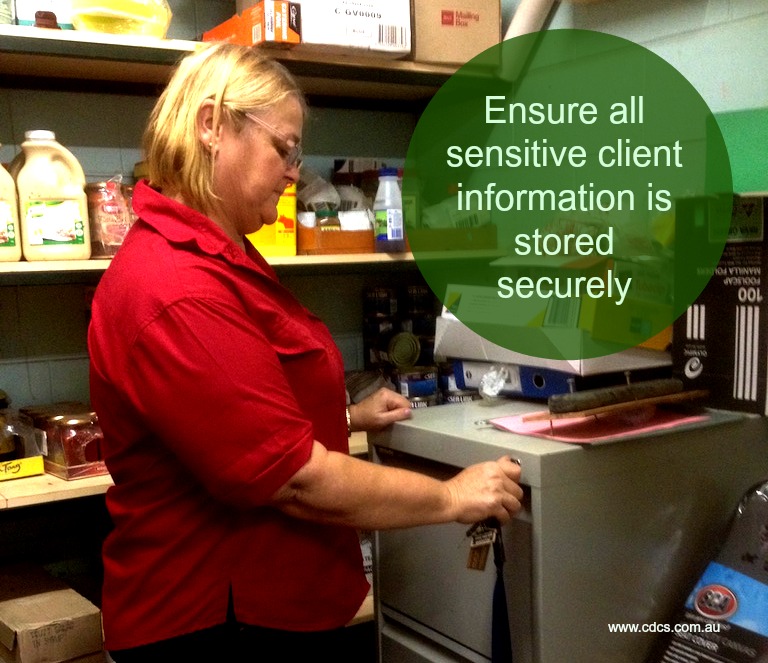Are you storing client information correctly?
Imagine you are a client of a business. You have provided the business with your personal details; your name, date of birth and contact details, including your address. The fact that you are a single person is also noted on the form you have filled out. Whilst seated in the office discussing your needs with the business manager, you notice the files of other clients lying open on the desk.
At one point in your conversation, the manager needs to go out of the office to clarify an issue with a colleague, leaving you alone with these client files. It would be easy for you to pick up any one of these and peruse if you so desired – in fact one of them is lying open in front of you, the person’s details clearly accessible to anyone wanting to read them.
How confident are you feeling about this organisation’s protection of your privacy?
Now look around you – how well are you protecting the privacy of the vulnerable clients in your organisation?
 Record-keeping practices can impact on both client outcomes and the reputation of an organisation. Clients of any business trust that their personal information will be handled and stored in an appropriate manner – when it becomes evident that there has been a breach of this trust, the relationship between the organisation and the client is affected.
Record-keeping practices can impact on both client outcomes and the reputation of an organisation. Clients of any business trust that their personal information will be handled and stored in an appropriate manner – when it becomes evident that there has been a breach of this trust, the relationship between the organisation and the client is affected.
The disclosure of sensitive information can also cause negative consequences for the individual whose details are at risk. I remember an incident in one organisation where an unauthorised staff member accessed and disclosed private information – this action resulted in a life or death situation for the young and vulnerable person involved.
Document security is an important aspect of the job for staff working in the community services sector.
Client progress notes, personal information and other documentation (whether in paper or electronic format) contain personal and medical information about a person that must be protected from the casual observance of unauthorised people.
There are standards and best practice guidelines backed up by legislation that cover issues around access, confidentiality and disclosure of personal information. Respecting the privacy of individuals should be a priority for all community service organisations.
But it’s not only the clients who have sensitive information on file.
Staff members also have personal information stored within the workplace environment and this needs to be protected as well.
To safeguard against unauthorised use, disclosure or loss of client or staff records, all organisations should have policies and procedures that provide guidelines for the correct storage of client and staff documentation.
Here are some tips for maintaining the security of personal information and client notes:
1. Paper-based copies of client records, including progress notes, should be kept in lockable storage such as a filing cabinet or cupboard, or in secured access areas when not in use;
2. Any documents that are no longer required and which contain client information should be shredded or archived appropriately – archived client information should also be stored securely;
3. Always log out of electronic Client Information Management systems immediately after you have completed your task to prevent someone accessing sensitive client information, as well as minimising the risk of someone adding additional notes under your electronic signature;
4. When leaving a computer unattended, passwords and screensavers must be employed to avoid casual observation and access;
5. If your organisation uses daily client plans to inform staff of activities for a client, these should be placed in a folder or location away from the general public;
6. Any requests for information about an individual should be provided only to appropriate personnel with the individual’s permission and / or according to your organisation’s policies and procedures;
7. All staff in your organisation should receive instruction on the correct handling and storage of client information and the organisational and legislative requirements of the Privacy Act.
Remember! It is also important to maintain the same privacy and security standards mentioned above for staff documentation.
This post is Part 4 of our four-part series on client documentation – check out our other posts now:
Part 1: 4 Ways to Make Client Documentation Easier
Part 2: Progress Notes – what should you document?
Part 3: 11 Tips for Writing Professional Progress Notes
- Operations Guides – Don't find yourself up that creek without a paddle! - January 31, 2020
- Planning to Succeed - January 10, 2020
- Effective Handovers and Their Role in Quality Care - September 20, 2019



